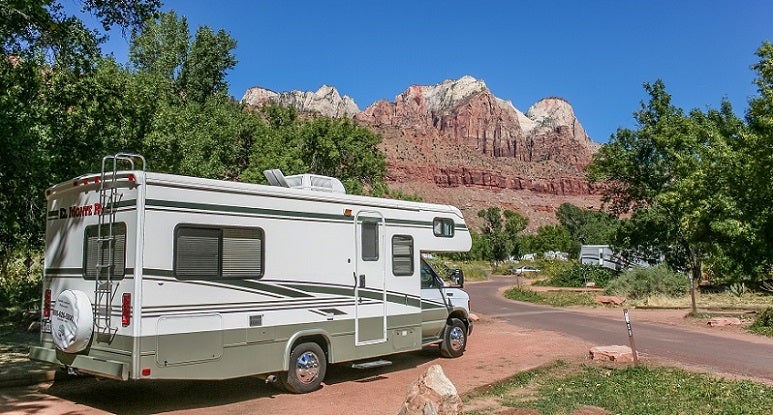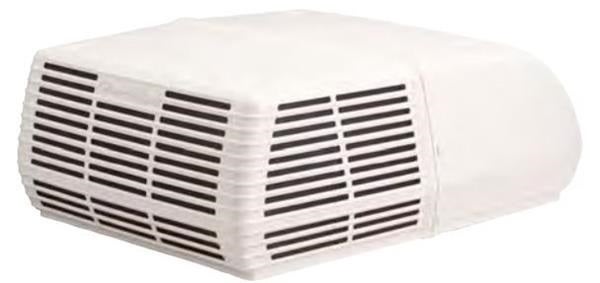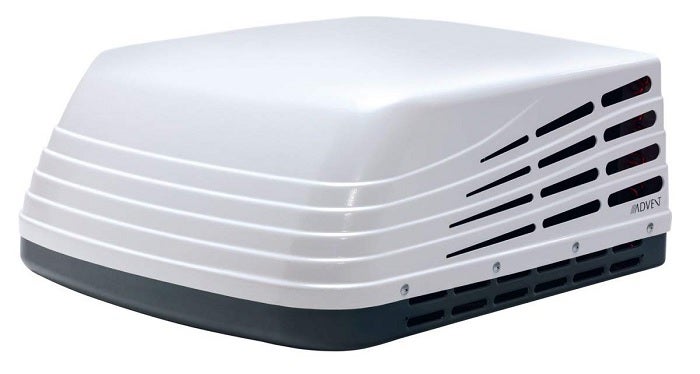
Our Editors independently research, test, and rate what we feel are the best products. We use affiliate links and may receive a small commission on purchases.
When you travel or live in an RV, it is your base of operations where you should feel comfortable.
Temperature is definitely an issue and driving or sleeping in the summer heat can become unbearable. The best RV air conditioners are not just for cooling your RV when its hot out, but can heat your RV as well.
There are lots of considerations to take into account before buying a unit. I’m going to help you learn how to buy your next RV air conditioner by walking you through what you need to know, step by step.
Then we will show you some of the top rated RV AC Units to choose from.
Best RV Air Conditioners
For more of my top RV recommendations, have a look through these popular Outside Pursuits guide links: RV Solar Panels & Kits, RV TV Antennas, RV GPS Navigation Units.
Quick Answer: The 3 Best Rated RV Air Conditioners
- Airxcel Mach 15+ RV Air Conditioner
- ASA Electronics ACM150 Roof Top AC
- Dometic Brisk II RV Air Conditioner
After our selection of RV AC units, we’ll further explain important features.
RV Air Conditioner Reviews
#1 Airxcel Mach 15+ RV Air Conditioner
- Installation Type: Ducted (non-ducted kit available)
- Capacity: 15,000 BTU/hour
- Electrical Rating: 120V AC (14.8 amp), 1,800 W
- Size & Weight: 42” x 28” x 16”, 90 lbs
- Heating: Heat strip available separately
- Extras: High-powered motor, 320 cubic feet per minute, streamlined shape, copper tubing, large evaporator, eco-friendly refrigerant, 2-year warranty
Look no further than the Airxcel Mach 15+ RV air conditioner for a ducted installation. Coleman is well known for reliable units, and this model is among the world’s most powerful RV air conditioners.
Equipped with a fan motor that delivers ⅓ horsepower, it might well be the strongest RV AC and delivers cool air at an incredible rate of 320 cubic feet per minute. The Airxcel Mach 15+ comes with a streamlined shape for enhanced airflow and cooling efficiency.
High-quality engineering makes this model a resistant powerhouse: the motor is fixed in relation to the blower and is mounted directly to the bulkhead, allowing the wheel to turn freely and blow straight down at no angle.
The motor’s shaft is sealed to protect it from damage and the elements, while the shroud is secured with corrosion-resistant stainless steel truss head screws. A plastic drain pan further bans corrosion.
All copper tubing and gas-flux brazed joints ensure a long lifespan and dependability. The system is further optimized for heat dissipation with large evaporator and condenser coils with raised lace fins.
Even under high temperature, in thick humidity and sweltering conditions, the air conditioner will start easily to deliver cold air.
With a high output, it’s your best bet for a ducted installation. The only knock on the Airxcel Mach 15 is it is noiser then the other RV AC s on our list.
It’s compatible with standard 14″ x 14″ vent openings. If you want a non-ducted installation, you’ll need a Coleman ceiling assembly kit, which is available separately.
For the non-ducted installation, you can also install a heat strip for warm air. The Airxcel Mach 15+ RV air conditioner is available in white or black and installation is fairly easy.
#2 ASA Electronics ACM135 Roof Top AC
- Installation Type: Non-ducted (ducted kit available)
- Capacity: 13,500 BTU/hour
- Electrical Rating: 110V AC (20 amp required), 2,800 W
- Size & Weight: 30” x 28” x 14”, 85 lbs
- Heating: Plug-in heat strip available separately
- Extras: Evaporator fins for high efficiency, quiet operation, removable and washable particle filters, motor overload protection, eco-friendly refrigerant, 2-year warranty
The Advent Complete RV air conditioner is all you need if you’re looking for a no-hassle non-ducted installation. With 13,500 BTU per hour, this is a high-performance model using an environmentally-friendly coolant.
After mounting the top unit onto the roof of your RV, you simply plug in the control unit without complex wiring. You’re able to choose between three fan speeds for your cooling needs. An optional plug-in heat strip can deliver warm air.
The model is designed to withstand tough conditions and uses high-grade materials. A rigid metal base pan provides a solid foundation while a sturdy frame constructed of metal and foam minimizes vibration and allows the unit to operate quietly.
The thick and watertight vent opening gasket is supported with six dense foam pads. Evaporator cooling fins improve the air conditioner’s efficiency while removable and washable filters keep the air and RV interior clean and free of particles.
The motor overload protection guarantees a longer lifespan.
The unit is compatible with standard 14.25″ x 14.25″ vent openings, but a ducted installation requires a kit and wall thermostat which are available separately.
The Advent Complete RV air conditioner is available in white or black and performs well so you can keep cool and relaxed in your motorhome.
#3 Dometic B59516.XX1C0 Brisk II RV Air Conditioner
- Installation Type: Ducted or non-ducted possible
- Capacity: 15,000 BTU/hour
- Electrical Rating: 115V AC, 60 Hz, 1 Phase
- Size & Weight: 12” x 27.2” x 12.7”, 74 lbs
- Heating: Heat strip available separately
- Extras: High-performance motor and fan, 2 year protection plus warranty, environmentally friendly, aerodynamic design
The Dometic Brisk II RV air conditioner is one of the best RV AC units because not only is it compact, lightweight and inexpensive, it is also sturdy, aerodynamic and very versatile.
It is straightforward to install on the roof of your vehicle and can be used for ducted or non-ducted operation.
Despite the minimal weight and dimensions, it has a strong performance and delivers 15,000 BTUs of cooling thanks to a powerful quiet motor and fan. It offers sufficient cooling capacity for most RVs.
Compared to previous models, Dometic has greatly improved the Brisk II with reduced weight and increased air flow. It is one of the smallest rooftop models available and it fits 14 x 14 standard air vents.
With a stable base pan and a rigid, aerodynamic shroud, you don’t need to worry about durability or drag and reduced fuel efficiency. Strong motor brackets, foam housings and sound dampening keep vibration and noise to an absolute minimum.
Light high-tech materials such as expanded polypropylene can withstand the stress of rough travel, dust and heat. With reinforced screw holes, you can rely on a safe installation. Insulation and a center air discharge optimize airflow and cooling capacity so no cold escapes.
The Dometic Brisk II unit as it comes is only for cooling. If you want heat for your RV, you will need the Dometic Brisk 2 Heat Strip for a non-ducted installation.
For operation, the Brisk II requires an air distribution box (ADB) for a ducted install or a thermostat (both are not included).
It’s compatible with the Dometic Universal ADB, Dometic Return Air Grill, and the Dometic Single Zone LCD thermostat or Comfort Control Center II thermostat. The model is available in white and black.
The Dometic Brisk II offers amazing value at a reasonable price and is a powerful and reliable RV air conditioner with specifications and compact dimensions that are hard to beat.
RV Air Conditioners Comparison Table
| RV Air Conditioners | Installation Type | Capacity | Electrical Rating | Size & Weight | Heating | |
|---|---|---|---|---|---|---|
| Airxcel Mach 15+ RV Air Conditioner |  | Ducted (non-ducted kit available) | 15,000 BTU/hour | 120V AC (14.8 amp), 1,800 W | 42” x 28” x 16”, 90 lbs | Heat strip available separately |
| ASA Electronics ACM135 Roof Top AC |  | Non-ducted (ducted kit available) | 13,500 BTU/hour | 110V AC (20 amp required), 2,800 W | 30” x 28” x 14”, 85 lbs | Plug-in heat strip available separately |
| Dometic B59516.XX1C0 Brisk II RV Air Conditioner | Ducted or non-ducted possible | 15,000 BTU/hour | 115V AC, 60 Hz, 1 Phase | 12” x 27.2” x 12.7”, 74 lbs | Heat strip available separately |
How to Choose the Best RV Air Conditioner – Buyers Guide
- Cooling efficiency
- Size
- Type of Installation
- How to Install an RV AC Unit
- Heating
- Power Consumption
- Ease of Installation
- FAQ
- Best RV Air Conditioner Brands
- Conclusion
An RV air conditioner provides comfort in your vehicle and helps keeps the air clean. It’s constructed to withstand vibration and adverse weather conditions while taking up less space than regular AC units or portable ones.
You’ll need to pay attention to the installation type, the capacity, electricity, as well as size and weight.
Cooling Efficiency
For a consistent cool in your vehicle, the three models we have reviewed can provide 15,000 BTU per hour. That is more than most pre-installed models which tend to stop at 13,500 BTU.
In terms of air output, the Coleman model is the most powerful one and is recommended for larger vehicles and ducted installations.
Size/Weight
Regarding the size of the AC unit that is mounted on the roof, you’ll want to consider wind resistance and vehicle clearance.
All three models in our selection are shaped aerodynamically to reduce drag, but pay attention to the height if your vehicle has limitations, for example for parking in a garage.
Then there is the size of your RV and the area you want to cool. One AC is enough to regulate the temperature in the cabin and sleeping area, but for longer, larger vehicles, you might need to install an additional unit.
Also verify that the A/C doesn’t exceed the weight limit for the roof of your RV.
Type of Installation
When deciding on a ducted or non-ducted installation for your RV air conditioner, consider the existing ducts and air distribution in your vehicle.
If there is an air distribution box already or you want the cold to quickly flow to different party, a ducted version is for you.
A non-ducted unit might be easier to install, and it’s also sufficient in situations where you mainly want to cool one area and the unit will sit almost directly on top of it, i.e. the cabin or the bed.
How to Install an RV Air Conditioner
This video shows installation of a Dometic Brisk Air, the procedure is similar for installing most any brand.
Heating Use
All three models are for use in hot climates to cool things down. For year-round use in cold weather, they can be upgraded with a heat strip to blow warm air as well. The Advent Complete air conditioner features easiest upgrade as it’s a plug-in installation.
Power Consumption
An air conditioner is among the most power-hungry appliances you’ll have in your RV and therefore requires a generator to run. Look at the wattage each unit require and compare it to what your existing setup can provide.
If you have don’t yet have a generator, make sure it can power all the appliances and devices you want to use at the same time – you’ll be looking for a model between 3,500 W and 5,000 W.
Ease of Installation
In most instances, installing an RV air conditioner does not pose a big hurdle and you can simply work off the provided instructions. Things become more complicated when combining parts from different manufacturers or customizing an existing system.
As far as maintenance is concerned, follow the recommended procedures for cleaning. Typically this only requires changing or washing filters as the unit itself is sealed.
FAQs About RV Air Conditioners
Q: Can I also heat up my RV with an air conditioner?
A: As they come, all of the models above only deliver cold air. Yet all of them can be equipped with an additional heat strip, which you’ll need to purchase separately. This allows the unit to suck in fresh air and heat it up electrically instead of cooling it down.
Q: What is the difference between a ducted and non-ducted installation?
A: All of the RV air conditioners we’ve reviewed feature a box that is mounted onto the roof of your vehicle. It contains consists of a base pan, which houses a condenser, compressor and blower, and a shroud to cover it up.
In a ducted installation, the roof unit connects to ducts inside your RV that distribute the air and you control the settings with a remote or wall thermostat. An air distribution box (ADB) typically forms an interface between the AC and the ducts.
Depending on the size of your vehicle and duct installation, different parts of the RV could require their own roof unit.
A non-ducted installation is more simple as it’s basically an AC sucking in air on your roof and blowing it out cold at the bottom, that is from the ceiling. A control unit (also called ceiling assembly) allows you to set the temperature.
Q: What does the term BTU indicate?
A: BTU is short for British thermal unit. BTU per hour is used to express the power of heating and cooling systems such as air conditioners.
A higher value indicates a more powerful output. 1,000 BTU per hour are roughly equivalent to 293 W, so a 15,000 BTU/h model has an approximate output of 4,500 W.
Q: Do I need additional hardware?
A: If you are replacing or upgrading an existing rooftop unit with one of the models above, you will not need additional hardware if the new model is compatible with your installation.
A ducted installation might require a thermostat or air distribution box, if you don’t have these already. A non-ducted installation needs a control unit. The Advent Complete Air conditioner is an exception and already includes the ceiling assembly kit.
Any AC requires a good deal of electricity, which should not be a problem when you’re stationed in a campground environment where you can get a hook-up.
On the road and in the wilderness, you’ll have to rely on a generator – which you need to bring in case your vehicle isn’t already equipped with one. Make sure the generator can deliver enough power for your AC.
Q: Does an RV Air Conditioner require professional installation?
A: This depends on your skills and circumstances. Should you be the type who generally fixes and optimizes everything on your RV, you’ll be fine. Replacing an existing rooftop unit is a straightforward installation and means just exchanging one box for another.
If you have installed an AC in your RV or home before, it’s likely not a challenge for you. If you can’t find any standard vents, don’t think your vehicle is yet equipped for any AC or are afraid of damaging the roof of your RV or trailer, consult a professional or trusted and skilled friend.
Best RV Air Conditioner Brands
There are several noteworthy manufactures of RV air conditioners that we’ll mention here:
Coleman: By far the largest manufacture of outdoor related equipment. You know them for tents and grill but they also make some of the best air conditioners.
Advent: A subsidiary of ASA Electronics, they make a full lineup of air conditioners, thermostats and controllers.
Dometic: Formed in the early 1900’s they have been making air conditioners for almost 100 years. They make air conditioners and refrigeration equipment for just about any purpose you can think of.
Conclusion
If you’re familiar with the comfort of air conditioning in your home or car, you’ll know that an RV air conditioner can be a must-have item as it will make driving and sleeping in hot temperatures so much more enjoyable.
Use our guide to figure out which type of air conditioner you need and then select the right one for you and your vehicle from the best models we have reviewed.
Whether you’re vacationing or permanently living the RV life, you’ll then be able to stay fresh and relaxed throughout the hot summer days.
How We Researched
To come up with the top RV Air Conditioners, we researched a variety of sources for reviews such as Camping World, Lazy Days, Real Truck and Walmart along with our own personal experience.
We also consulted online magazines for product research and reviews to get as much unbiased information as we could. To help weed out fake reviews we used Fakespot.com to make sure we only looked at genuine reviews.
With so much quality gear available, we had to narrow it down based on what we felt were the best options for the price. The staff authors have a wide and varied background in RV camping, automotive repairs and backpacking.
The authors have decades of experience and are eager to share their knowledge with readers.
To help narrow down the selection we used personal experiences along with recommendations from mechanics and retailers.
After extensive research, we came up with our list to help you choose the right one for you.
Sources
I hope this guide was helpful for finding the best RV Air Conditioner to fit your needs. If you want to comment or recommend an A/C I didn’t include, please use my contact form to get in touch.
Happy travels in your RV and have a safe journey!



Would be helpful to have real life dB comparisons
Hi Gary,
I would agree but I don’t have that type of equipment.
As Gary pointed out noise levels need to be included in the comparison, and yes I know you did not have the equipment to measure them. Problem is noise levels are the #2 complaint below cooling output.
We have the Airxcel Mach 15 unit as a front AC and it pumps out the cold. On a 90 degree day it keeps the bedroom in the mid 60’s. Great selling point but it’s so loud it drowns out large V16 diesel engines nearby. We are so use it the noise it puts out we use it for white noise. TV in the bedroom is useless because it can’t overcome the sound of the Mach 15.